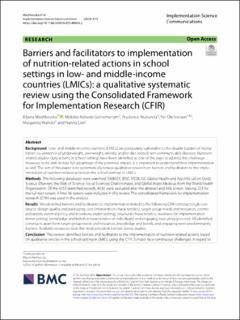| dc.description.abstract | Background
Low- and middle-income countries (LMICs) are particularly vulnerable to the double burden of malnutrition: co-existence of underweight, overweight, obesity, and/or diet-related non-communicable diseases. Nutrition-related double-duty actions in school settings have been identified as one of the ways to address this challenge. However, to be able to take full advantage of the potential impact, it is important to understand their implementation as well. The aim of this paper is to systematically review qualitative research on barriers and facilitators to the implementation of nutrition-related actions in the school settings in LMICs.
Methods
The following databases were searched: EMBASE, ERIC, MEDLINE, Global Health and PsycInfo (all on Ovid), Scopus (Elsevier), the Web of Science Social Sciences Citation Index, and Global Index Medicus from the World Health Organization. Of the 4253 identified records, 4030 were excluded after the abstract and title screen, leaving 223 for the full-text screen. A final 36 papers were included in this review. The consolidated framework for implementation research (CFIR) was used in the analysis.
Results
We identified barriers and facilitators to implementation linked to the following CFIR constructs/sub-constructs: design quality and packaging, cost (intervention characteristics); target group needs and resources, cosmopolitanism, external policy and incentives (outer setting); structural characteristics, readiness for implementation (inner setting); knowledge and beliefs (characteristics of individuals) and engaging, executing (process). All identified constructs apart from target group needs and resources, knowledge and beliefs, and engaging were predominantly barriers. Available resources were the most prevalent barriers across studies.
Conclusion
This review identified barriers and facilitators to the implementation of nutrition-related actions based on qualitative articles in the school setting in LMICs, using the CFIR. Schools face continuous challenges in regard to funding and the government sector may have a role to play not only by offering financial assistance, but also through policy-making that would support healthy eating practices on school grounds. | en_US |

